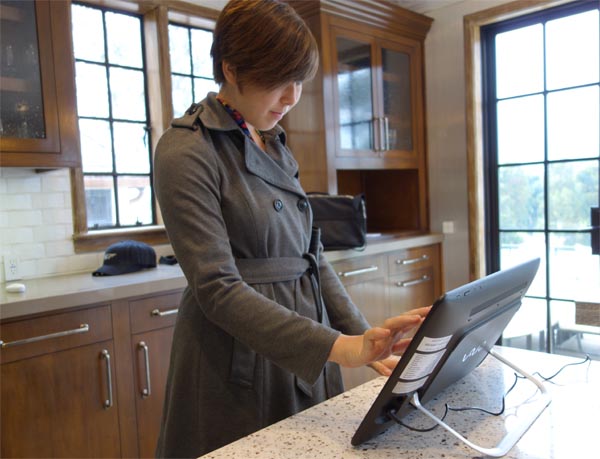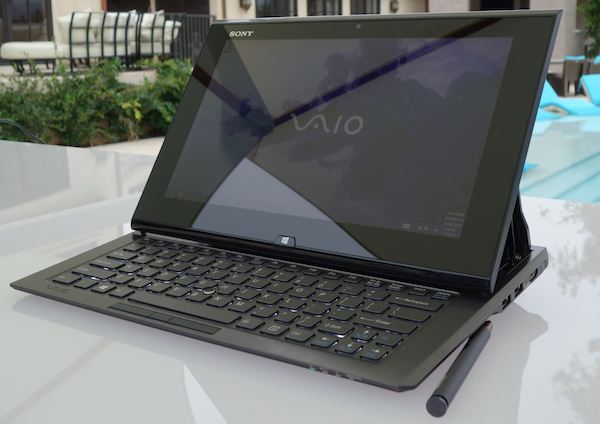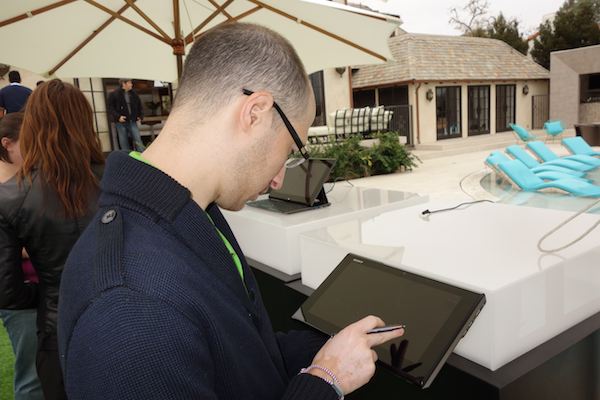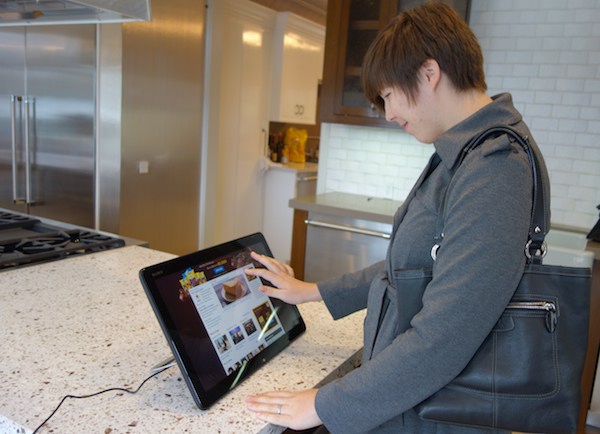
We were recently invited to a Windows 8 launch party, hosted by Sony at the House of Rock mansion. The event was designed to give members of the press and Sony sales representatives hands-on time with their new fleet of notebooks and desktops. The event featured engineers and reps from Sony, Microsoft, and Intel who walked us through some of the latest features and answered all of our questions.
During our time there, we were able to poke and prod Sony’s latest VAIO fleet, running Windows 8 with and without touchscreen variations and to say we walked away impressed is an understatement. With a simplified lineup, more powerful options and innovative features, Sony’s new fleet is quite simply the most compelling reason to upgrade to the latest OS from Redmond which heavily relies on touchscreen.
One thing that’s clear about Sony’s VAIO fleet this year compared to years prior is its simplicity. Instead of a dizzying 13 different series with letters that most don’t know the meaning of, Sony has opted for four notebooks (Z, S, T, E), the new hybrid DUO, and two desktops (Tap 20, L). While not quite as easy to understand as Apple’s lineup with easy names like MacBook Pro, MacBook Air, and iMac, the VAIO fleets been broken down into much simpler categories than before:
VAIO Notebooks:
Z Series; starts at $1,440 with an 13.1-inch and is designed to be powerful, lightweight, and aimed at the professional crowd with a carbon fiber body. (This series not does ship with Windows 8)
S Series, starts at $799 with an 13.3/15.5-inch and targets the media heavy crowd with up to 1TB hard drive and 8 colors in carbon fiber.
T Series, starts at $669 with an 13.3/14-inch and is offered only in silver as part of their Ultrabook fleet.
E Series, starts at $449 with an 11.6/14/15.5/17.3-inch and aims for the budget conscious shoppers among us.
DUO, starts at $1,099 with an 11.6-inch touchscreen and offers a mixture of laptop and tablet.
VAIO Desktops:
L Series, starts at $1,199 with a 24-inch touchscreen, and offers up to 16GB RAM and a 3TB hard drive with a built-in TV tuner.
Tap 20, starts at $999 with an 20-inch touchscreen and up to 2:45min battery lifetime.
Simplified Fleet:
When we walked away from our elegant outing, which included cocktails and a live band, one thing was apparent: Sony’s new simplified fleet is much more flexible, powerful, and competitive than before. The notebook lineup now consists of the entry level E Series, Ultrabook T Series, media focused S Series, and professional targeted Z Series. While at its core the series offers 4 different branches, each model is highly configurable with many different options, including more RAM, hard drive space, Blu-ray drive, screen size, and more. For those seeking a desktop, the VAIO Tap comes with a built-in battery, allowing you to be portable in the house while the L Series offers an all-in-one desktop solution.
Besides the VAIO S and Z where touchscreen is not offered, most models in the E and T series offer 1o point touchscreen (Windows 8 has a 5 point minimum requirement) while the VAIO Duo, Tap, and L come standard with screen smudging.

DUO and Tap:
The most impressive and compelling part of Sony’s fleet is reserved for the VAIO DUO and Tap 20. Appropriately so, both fit your portable needs in an exciting manner that you might not have thought you needed before. Let’s get one thing out of the way. The VAIO DUO is not a tablet and, unlike the Microsoft Surface (especially the Pro edition which starts at $1,000 when you consider the keyboard attachment and still offer limit inputs/outputs and a 4.5 hr battery lifetime) the VAIO DUO knows it’s a laptop. While the battery life is about the same, the VAIO Duo instead offers a traditional keyboard, functions with a normal mouse, and has:
- USB 3.0 (2x)
- VGA Out
- HDMI Out
- Memory Stick/SD Card Reader
- 128GB hard drive
- 6GB RAM
- Intel i5 Processor
 That means, for about $200 more, you can get more RAM (4GB on Surface Pro), more inputs/outputs, twice the hard drive space, and a real keyboard. If you’ve got money to spare, for the $1,499 VAIO DUO, Sony will bump you to a a Intel i7 processor, 8GB RAM, and a 256GB hard drive. When the Sony engineers built this thing, they didn’t want to comprise what a laptop should be and nor have they. They’ve built one of the best and sleekest looking ‘Ultrabooks’ – if we can call it that. This makes the VAIO DUO a fantastic and portable laptop, except when its not.
That means, for about $200 more, you can get more RAM (4GB on Surface Pro), more inputs/outputs, twice the hard drive space, and a real keyboard. If you’ve got money to spare, for the $1,499 VAIO DUO, Sony will bump you to a a Intel i7 processor, 8GB RAM, and a 256GB hard drive. When the Sony engineers built this thing, they didn’t want to comprise what a laptop should be and nor have they. They’ve built one of the best and sleekest looking ‘Ultrabooks’ – if we can call it that. This makes the VAIO DUO a fantastic and portable laptop, except when its not.
That’s because, with a slide of its screen, the VAIO DUO will turn into the best Windows 8 “slate” as well. Gone is the keyboard and instead, you’re holding a 11.6-inch 10-point touchscreen unit. While running the same software as the Surface Pro, you now have the ability for more inputs/outputs and the option to transform back into a laptop without compromise. Even better, Sony has designed to unit to work with their battery sheets, allowing you to extend the unit’s battery lifetime. I haven’t said this in a long time but bravo Sony. Now please, market the hell out of this!
While one innovative product release is good for any company, two should be a call for celebration and that’s exactly what Sony has done. The VAIO DUO is something that’s existed in forms like it in the past, albeit done horribly. The Tap, or Tap 20 as Sony staff members call it for its 20-inch screen, is something from left field. Like the VAIO DUO, the Tap is a fantastic 20-inch all-in-one desktop that starts at $879, well bellow the iMac and past Sony units. The base model lands you with a modest:
- Intel i3 Processor
- 4GB RAM
- 500GB hard drive
- 10-point touchscreen
For $100 more, you can jump yourself up to an Intel i5 and a 750GB hard drive. Those who want to further beef up their unit, rest assured that Sony has more RAM, hard drive, and processor options available for you. Like most all-in-one desktops, Sony has removed the optical drive and you can expect the standard Sony Exmor HD camera and Dolby sound system. This again is the fruition of engineers who sat around and knew exactly what they wanted to create: a modern desktop that comes in black and white. So does this make the VAIO Tap one of the best Sony desktops ever? It does, except when it’s not a desktop.
 You see, unlike traditional desktops, you can unplug the Tap 20 and let it run on its internal battery for 2 hours and 45min. That’s right: Working on a project upstairs but would like to relocate to your backyard for a bit because you live in California and it still gets to mid 70’s in late November? No problem. Kids need to do homework but need your help? Just grab the desktop from their room and bring it into the kitchen. The truth is, if you can dream of a portable situation where you’d like to have a nimble and large screen with you (11.46lb) the Tap 20 can offer that. This is perfect for those who might want to have a computer for downstairs and/or their kitchen. But why stop there? Imagine the commercial use for a device like this in firms, offices, and restaurants. In fact, if you’ve seen the Windows 8 commercial with the adorable little girl doodling on the computer, you’ve seen the Tap 20. Hello party games, right?
You see, unlike traditional desktops, you can unplug the Tap 20 and let it run on its internal battery for 2 hours and 45min. That’s right: Working on a project upstairs but would like to relocate to your backyard for a bit because you live in California and it still gets to mid 70’s in late November? No problem. Kids need to do homework but need your help? Just grab the desktop from their room and bring it into the kitchen. The truth is, if you can dream of a portable situation where you’d like to have a nimble and large screen with you (11.46lb) the Tap 20 can offer that. This is perfect for those who might want to have a computer for downstairs and/or their kitchen. But why stop there? Imagine the commercial use for a device like this in firms, offices, and restaurants. In fact, if you’ve seen the Windows 8 commercial with the adorable little girl doodling on the computer, you’ve seen the Tap 20. Hello party games, right?
The truth is, when Sony launched the VAIO line over a decade ago, they had some of the most compelling designs in a PC industry that was crumbling on itself, due to lackluster units with no inspiration. Sony would eventually fall behind as a small, premium maker while HP and others stepped up their designs and offering. This secluded Sony to offer high-end units and when they did try to dabble in the low end market, they failed miserably by offering uncompetitive features at their respective price points. This new fleet from Sony changes all of that. Not only is their entire fleet competitive at their given prices, but the VAIO DUO and Tap offer some extremely compelling devices that no one else is offering.
The last time I owned a PC was a VAIO notebook in 2003 when Intel Centrino chips were just coming to the market. Since then, I’ve gone to Apple and haven’t looked back with good reason. For the first time, Sony has made me want a PC, something I never though I would say and that’s saying something, seeing how I worked for the folks at Cupertino for four years before becoming a consultant for them, which is where I’m at now. If Sony has my attention, there is no reason that they shouldn’t be able to sell droves of their entire new fleet to the legions of PC users out there.
[fsg_gallery id=”7″]
Discuss:
Have questions about Sony’s Windows 8 fleet? Post them in the comments section and we’ll do our best to answer them.
Update:
A small correction, while our specs on the VAIO Z and lack of touchscreen were correct in the above article, we mistakenly listed the unit as offering Windows 8 which it does not. Thanks to reader Aigak for pointing this out!

You must be logged in to post a comment.